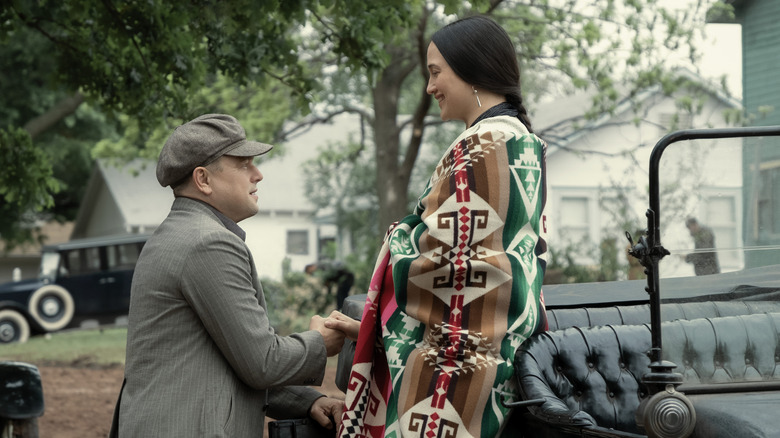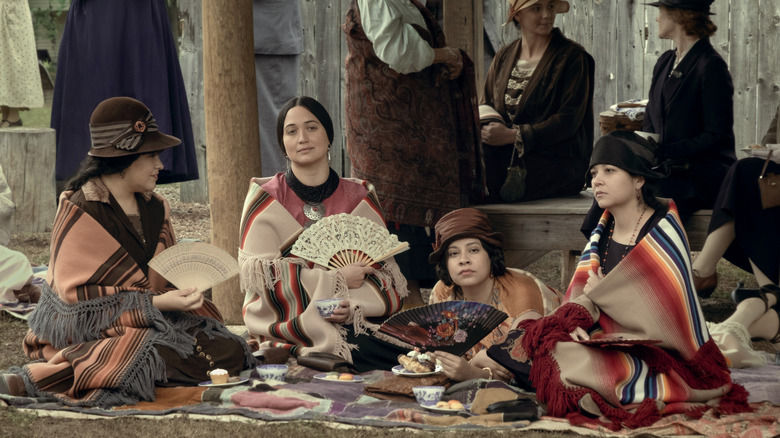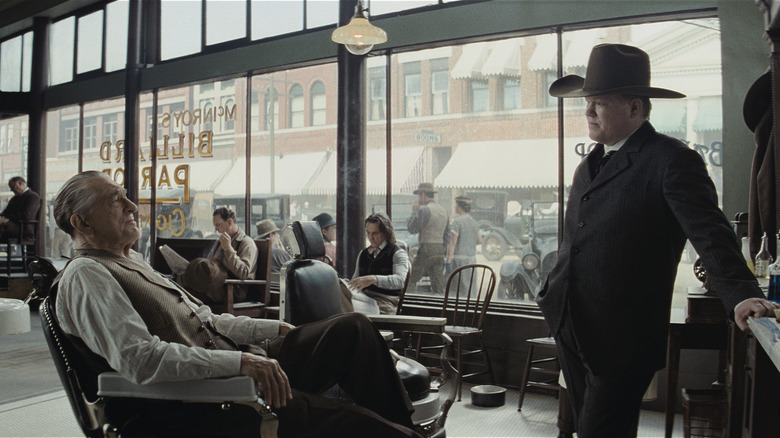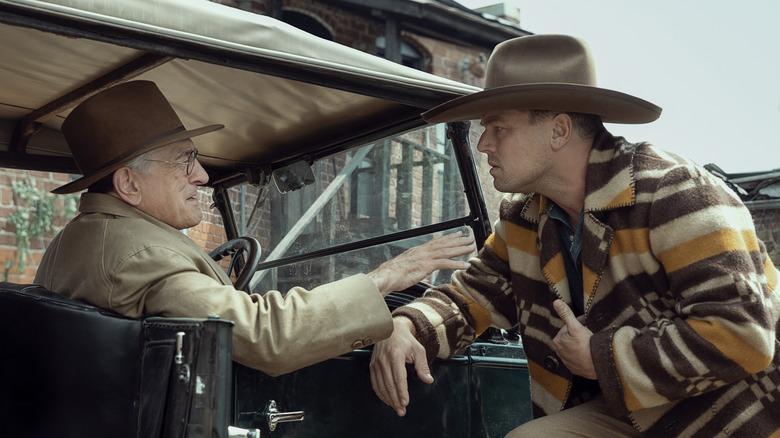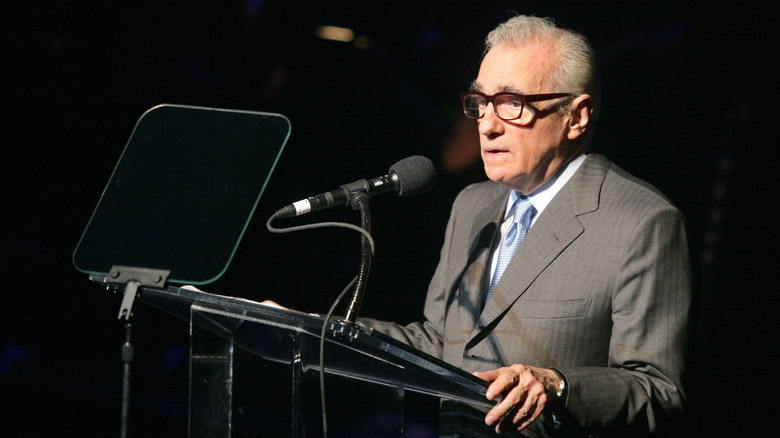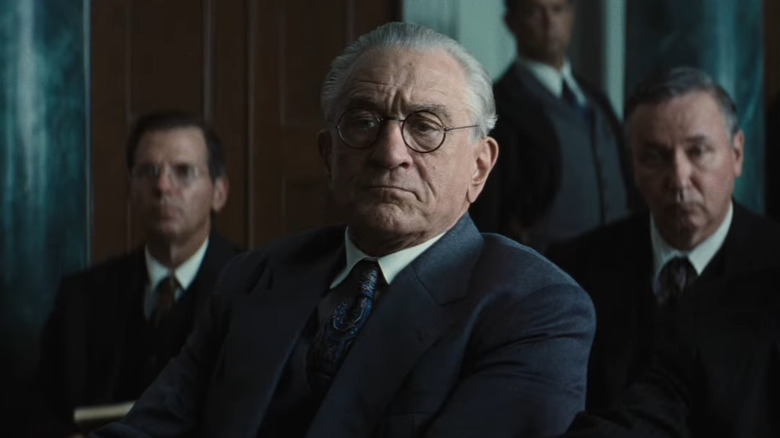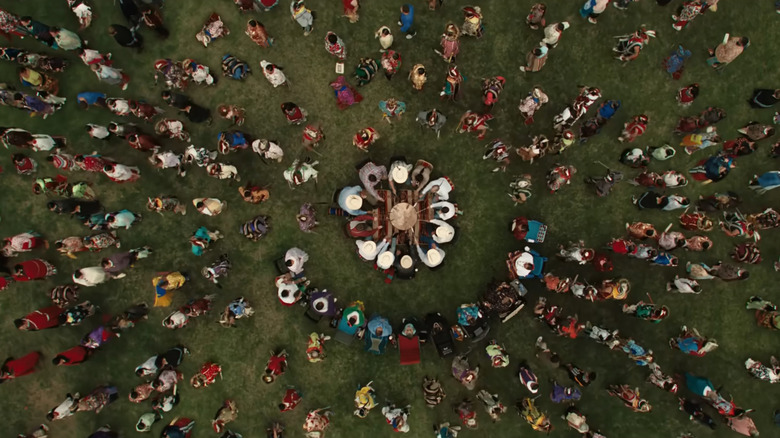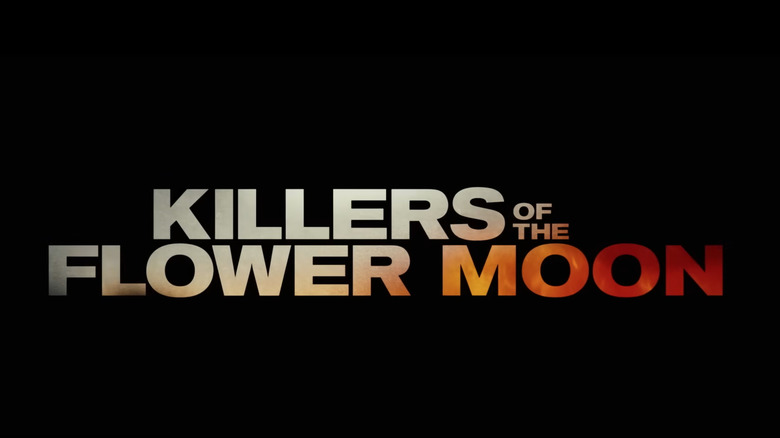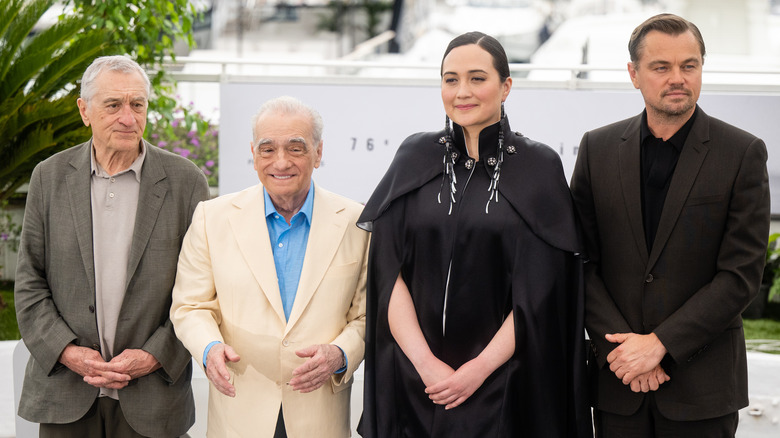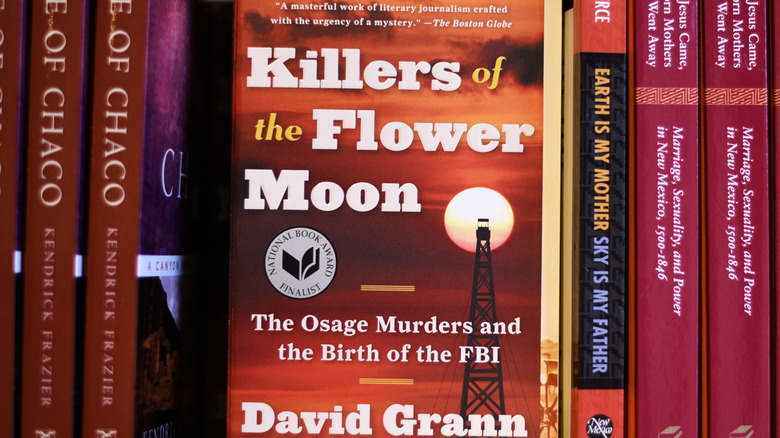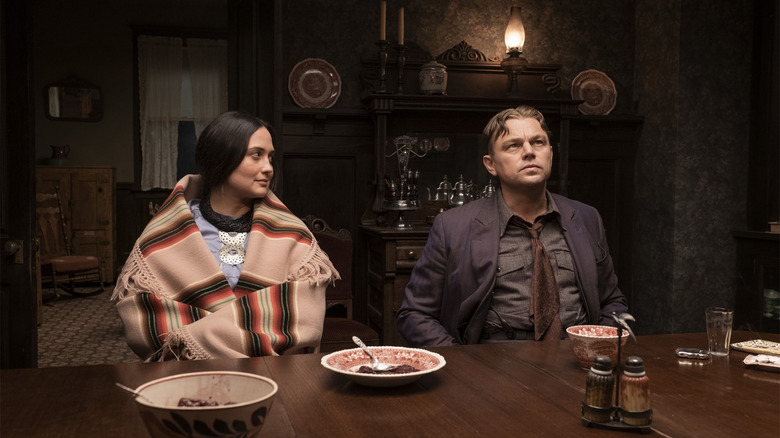The Ending Of Killers Of The Flower Moon Explained
Contains spoilers for "Killers of the Flower Moon"
Martin Scorsese's "Killers of the Flower Moon," based on the non-fiction book of the same title by David Grann, is the largest-scale Western to come to theaters in a long time — though it's far from the traditional Western. This 3.5-hour-long epic, featuring Scorsese regulars Leonardo DiCaprio and Robert De Niro and a star-making turn from Native American actress Lily Gladstone, is also a crime thriller, a tragic love story, and a look at some of the most upsetting aspects of American history.
It's a lot. There's so much going on in "Killers of the Flower Moon" that even deciding what qualifies as the film's "ending" is subject to debate — Is it the last hour? The last half hour? The final scene? This article will dig into the ending of the movie piece by piece, looking at the reasons why Scorsese made the directorial choices he did in choosing to present this story's conclusion in its distinctive manner, and how these decisions reflect the bigger themes at play.
What you need to remember about the plot of Killers of the Flower Moon
"Killers of the Flower Moon" opens with the Osage people in Oklahoma striking oil. By the 1920s, this discovery had turned them into the wealthiest group of people in the world — except that racist laws render them "incompetent" and require white "guardians" to handle their wealth. Many Osage are being murdered, and the police are doing nothing to solve the cases.
William King Hale (Robert De Niro) is one white man using this situation for his own benefit, and ropes his war veteran nephew Ernest Burkhart (Leonardo DiCaprio) into an elaborate criminal scheme: Marry into an Osage family, then kill the members off one by one until the oil money is all theirs. Ernest actually falls in love with his new wife Mollie (Lilly Gladstone), but still partakes in the violence against her family due to a combination of greed and his uncle's manipulations.
Mollie is diabetic, and gets prescribed the new, rare, and extremely expensive drug insulin. Distrusting the doctors, she has her husband perform the shots for her. Unbeknownst to her, Ernest is following the doctors' orders to mix the insulin with a poison to "slow her down," gradually sickening her. Afraid she's going to die, Mollie uses what little strength she has left to travel to Washington D.C. to plead to President Calvin Coolidge for an investigation into the unsolved murders. It works: Agents from the Bureau of Investigation (BOI), led by Tom White (Jesse Plemons), come in and arrest Ernest. Hale casually turns himself in, confident he'll be ruled innocent.
What happened at the end of Killers of the Flower Moon?
In the final act of "Killers of the Flower Moon," Ernest wavers back and forth on whether to testify against Hale. Ernest makes confessions only to take them back and claim he was forced to by the BOI; He shows up in court without realizing he and his uncle have the same lawyer, W.S. Hamilton (Brendan Fraser), who works further to scare him off from testifying. In jail, Ernest learns his youngest daughter has died of whooping cough, but surprisingly, Mollie is still alive and has gotten help recovering from the poisoning. Ernest has an emotional reunion with his wife. The trials continue to unearth evidence of the conspiracy despite Hale's best efforts to suppress it, and Ernest ultimately testifies and pleads guilty to killing Rita (JaNae Collins) and Bill Smith (Jason Isbell) by blowing up their house. But he won't confess to everything — in his last scene, he lies to Mollie, still saying the shots he gave her were just regular insulin.
The film continues into an epilogue of sorts, where the story of the Osage murders is presented via a live performance of a true crime radio play. The energetic fast-paced deliveries and wacky sound effects make it easy to miss all the details, but this epilogue describes what happened in the aftermath of the story. We hear how Ernest and Hale both ended up free on parole despite their life sentences and, in a cameo from Martin Scorsese himself, how Mollie's obituary made no mention of the murders. The final shot of the film shows a massive Osage drum and dancing circle from overhead.
What the ending of the movie means
Like Scorsese's past crime films, "Killers of the Flower Moon" is about the all-consuming power of greed in the American capitalist system. Here, this theme also plays into the reckoning with the mass genocide of Indigenous people. Ernest makes for a particularly complicated protagonist because on the one hand, he seems to genuinely love his wife — but on the other hand, he's both so greedy and so easily manipulated that this love ultimately means nothing.
More than anything, Ernest is a weak man, and the way he's pulled back and forth over the course of the trial in the film's final act serves to emphasize that weakness. The scene in which Hamilton brings Ernest to a meeting with the oil company execs to put the fear of God into him evokes Ned Beatty's scene in "Network," another film about the forces of the market doing everything to suppress dissent. You might watch the final act of "Killers of the Flower Moon" hoping for Ernest to find the strength to stand up to Hale and acknowledge his crimes, but his confession offers little catharsis.
Ernest's final interactions with Mollie only serve to emphasize his dishonesty and cowardice. Mollie never really trusted him, identifying him as a "coyote" from the beginning, but nonetheless chose to spend her life with him. By the end of the film, she fully sees through his charming facade, wanting nothing more to do with him.
What the radio epilogue means
On the most basic level, presenting the final facts of the story in the form of a live radio show offers a more entertaining alternative to the standard practice of closing historical films with informational title cards. The choice to present this information so entertainingly, however, comes with its own layers of commentary on the nature of the true crime genre as a whole and on Scorsese's own responsibilities with "Killers of the Flower Moon" in particular.
For one thing, there's the question of entertainment as a distraction. After over three hours of methodically paced storytelling, suddenly getting bombarded with a presentation so fast and so silly creates a weird disjoint where it's harder to take in the sadness of the story being told. This radio show is specifically stated to be associated with FBI director J. Edgar Hoover, which raises questions about the propagandistic usage of such stories.
The images of the theater audience recall how Scorsese ended "The Wolf of Wall Street," forcing the viewer to reflect on their own attraction to such stories in the first place. Not letting himself off the hook either, Scorsese appears onstage as part of the radio show — but when he's talking about Mollie's divorce, remarriage, and death, the bells and whistles fade away. He wants us to take this in. That's what "Killers of the Flower Moon" is trying to accomplish: To offer serious reflection on tragedy within the apparatus of mass entertainment.
Hale's view of history looms large over the ending
Whereas Ernest is the sort of villain who lacks any serious sense of right or wrong, Hale is the kind who's convinced himself he's in the right — which is what makes him so scary. He's convinced the Osage Nation he's their ally, and he can talk at length about the virtues of their culture, and yet he still wants to take everything from them because he views their fall as a historic inevitability. It's an even more extreme parallel to Ernest professing love for the same woman he's slowly poisoning.
Speaking to Ernest in jail, Hale delivers a chilling monologue affirming his confidence that history will vindicate him, because all the anger people hold towards him now will end up forgotten. To some degree, this confidence was scarily well-founded: He and the other convicted killers were eventually let free, while other killers weren't caught or convicted at all, and the broader culture generally forgot about this story for a long time. Yet even if white America forgot, the Osage Nation did not forget — when Hale was let out of prison, his release was met with protests. And though it's taken far too long, the existence of "Killers of the Flower Moon" as both a book and a movie is also a rejoinder to Hale's view of history: What might have once been forgotten is now being remembered on a large scale.
The purpose of the final shot
As with the radio epilogue, the closing shot of "Killers of the Flower Moon" seems to serve two primary purposes: one stylistic and one thematic. The stylistic purpose of the final shot is the sheer visual splendor of it all. With a reported budget of $200 million, this production had plenty of resources for stunning scenes with massive crowds and fancy camera work, but Scorsese restrains those more grandiose instincts for much of the film in favor of a more intimate focus on character drama. The ending offers a place where such a spectacle fits comfortably.
Thematically, the final shot returns the central focus of the film to the Osage people. Trying to navigate the issue of perspective was one of the challenges of making the film. Most of the significant Native American characters are killed midway through the film, and Mollie, the main exception to this rule and one of the most important characters, still has to spend a large chunk of the film bedridden while the white male exploiters take center stage in the drama. Presenting the Osage perspective on this tragedy, however, was one of Scorsese's priorities in telling this story. The movie opens from their perspective, and after the radio drama segment entirely about white America's viewpoint, the closing shot returns the movie to them. The start of the credits solidifies this, with the film's title displayed in the Osage language before it is shown in English.
Meaning in Killers of the Flower Moon's credits
Scorsese's thoughtful direction continues even beyond the end of the narrative into the credits themselves. It's not as if the credits are some gorgeous Saul Bass-inspired graphic sequence or that there are any Marvel-esque post-credits Easter eggs (though that would be deliciously ironic if there was, given Scorsese's criticism of the modern superhero cinematic machine). It's a simple, traditional end credits roll, but pay attention to the sounds in the background: They're the sounds of nature that Mollie teaches Ernest to listen to at the start of their courtship.
When Sight and Sound pointed this out in an interview with Scorsese, the filmmaker waxed poetic on the subject: "The music comes from there. It always did. That's how music originated, from imitating animals and the sounds of insects. And so you get the goat singers, you get the ancient world, the tragedy, again, from that. And that's for us to go back to and to find comfort in. I think. Of course, I'm a part of this and I love this [gestures out of the window at midtown Manhattan], but it's not the way to live, not the way for human beings to live."
What has the cast and crew of Killers of the Flower Moon said about the ending?
Well before the release of "Killers of the Flower Moon," Osage Nation Principal Chief Geoffrey Standing Bear, who advised Scorsese on the film's cultural depictions, discussed the filming of the film's closing shot, revealing it was a relatively late addition. "I heard that Mr. Scorsese and the producers are going to come back and try to get a better ending by showing everyone who was an extra in a social dance where everyone's having a good time," Standing Bear stated in March 2022 (via Tulsa World).
Speaking to Vogue during the movie's premiere at the Cannes Film Festival, Gladstone made sure to inform people of one of her favorite details in the true story that wasn't included in the film: "It's not in this film, but it's important to me that people know that Mollie, once she divorced Ernest, she didn't just cut and run — she went back and got the money from him that he'd embezzled from her." In an Interview Magazine talk with director Kelly Reichardt, Gladstone described using quotes from those later court cases to base her performance of the film's ending scenes on, saying, "I don't want harm to befall my husband. But I want the truth to come out for what it is."
Closer to release, Scorsese has talked more about aspects of the film's final act in interviews. He told The New Yorker that the film's ending was harder to write than the beginning, explaining, "The first two hours, we were moving along. The second two hours, boy, is this getting a little long in the tooth, as they say." Once the script was finally figured out, he became very enthusiastic about it — in his interview with Sight and Sound, Scorsese raved about the dialogue in the scene where Hale threatens Ernest against testifying: "Oh, he does threaten him in a beautiful way."
How does the ending of Killers of the Flower Moon compare to the book?
The "Killers of the Flower Moon" movie captures much of the book's content but is completely different in terms of structure. The book is divided into three major sections or "chronicles." The first chronicle, "The Marked Woman," is centered around Mollie and her account of the crimes against her family. The second, "The Evidence Man," follows Tom White and the BOI as they uncover Hale's big conspiracy. Finally, "The Reporter" shifts the focus to the book's author, David Grann, as he personally investigates the case further and uncovers the extent to which the BOI overall failed to bring about justice.
Even if Scorsese's film adaptation had stuck closer to the structure of the book (and it very nearly did), there was almost no way the book's ending could be directly adapted. To even attempt that, the film would either have to shift to a documentary format or there would need to be a big meta framing device similar to what Ava DuVernay has done in adapting Isabel Wilkerson's book "Caste: The Origin of Our Discontents" as the movie "Origin." Scorsese gets a bit meta with the radio show epilogue, but that's different from making the whole third act about a writer living nearly a century later.
Killers of the Flower Moon's alternate ending
As far as we know, "Killers of the Flower Moon" doesn't have an alternate ending filmed. There is, however, an entire alternate screenplay. Eric Roth's original draft was closer to the mystery structure of the book as well as to more traditional Westerns, with Tom White as the primary viewpoint character. As Roth and Scorsese worked on developing the script, they realized they had to completely start over for multiple reasons.
Putting the focus on the BOI made it too much of a white savior story, and with Hale so obviously a villain with De Niro in the role, the BOI-centric version failed as a compelling mystery. "So, what is it?" Scorsese recounted to Deadline. "A police procedural? Who cares! We've got fantastic ones on television." DiCaprio, who was originally going to play White, reportedly questioned Scorsese, "Where's the heart in this movie?" Scorsese determined that the heart was in the twisted romance between Ernest and Mollie, a topic which only became more interesting to him while doing research and speaking with members of the Osage who claimed the love between the couple was real despite how badly Ernest was hurting Mollie. DiCaprio switched roles from White to Ernest, and the movie you see today came into being.
